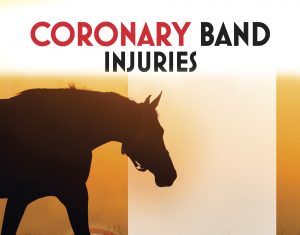Coronary Band Injuries
Click here to read the complete article
292 – March/April, 2022
Injuries are fairly common in horses because they are large and strong, and highly mobile. Domestic horses in small enclosures injure themselves more often than a less active species. Horses in athletic careers often have greater risks for injury because of the speeds they travel, with more stresses on feet and legs.
Coronary band injuries are often traumatic. This can happen if a horse tangles with a fence or puts a foot somewhere it doesn’t belong, or may occur in performance horses working at speed—catching one foot with another. Duncan Peters DVM, DACVSMR, ISELP Certified Member, East-West Equine Sports Medicine, Lexington, Kentucky says many of these coronary band injuries are severe lacerations.
“If the horse gets a little unbalanced during a speed workout, one foot may come up and catch the coronary band of another foot, and cause significant trauma. This might be anything from bruising to lacerations,” he says.
Dr. Mark Cassells (Homestead Veterinary Hospital, Villa Ridge, Missouri) says some coronary band injuries can be problematic for future soundness unless they are handled appropriately. “Horses can easily injure the coronary band if another foot comes up and lands on the coronary band—which may bruise or slice it. This might be an opposite limb or a hind foot landing on a foreleg,” he says.
Click here to read the complete article
292 – March/April, 2022











